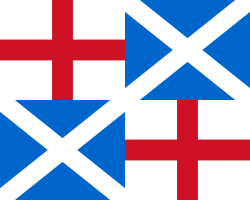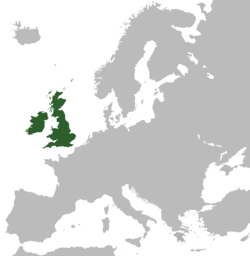Commonwealth of England
| 1649–1653, 1659–1660: Commonwealth England 1653–1659: Commonwealth England, Schottland und Irland | |||||
| 1649–1653, 1659–1660: Commonwealth of England 1653–1659: Commonwealth of England, Scotland and Ireland | |||||
| 1649–1660 | |||||
| |||||
 | |||||
| Amtssprache | Englisch | ||||
| Hauptstadt | London | ||||
| Staats- und Regierungsform | Republik | ||||
| Verfassung | Instrument of Government (1653–1657) Humble Petition and Advice (1657–1660) | ||||
| Staatsoberhaupt, zugleich Regierungschef | 1653–1659: Lordprotektor | ||||
| Währung | Pfund Sterling | ||||
| Errichtung | 1649 | ||||
| Vorgängergebilde | Königreich England Königreich Irland Königreich Schottland | ||||
| Endpunkt | 1660 | ||||
| Abgelöst von | Königreich England Königreich Irland Königreich Schottland | ||||
 | |||||
Commonwealth of England war die offizielle Bezeichnung der englischen Republik von 1649 bis 1660. Das Commonwealth umfasste zunächst nur England (inklusive Wales), dann auch Schottland und Irland.
Geschichte
Am Ende des englischen Bürgerkriegs von 1642 bis 1648 wurde am 30. Januar 1649 König Karl I. hingerichtet. Weitere knapp vier Monate später, am 19. Mai desselben Jahres, wurde mit dem Act declaring England to be a Commonwealth das Commonwealth eingeführt. Von Anfang an hatte sich Oliver Cromwell, einer der Führer im Bürgerkrieg, hervorgetan. Er schlug royalistische Aufstände in Irland (1649) und Schottland (1650/51) nieder. Das Commonwealth hatte weder Oberhaus noch König, das Unterhaus wurde alleiniges „Parliament of England“. Die drei höchsten Würdenträger waren der Parlamentssprecher, der Präsident des Armee- und der des Staatsrats (Council of State). Dieser Rat hatte die Regierung inne und wurde vom Parlament ernannt.
Die im April 1653 eingeführte Verfassung „Instrument of Government“ setzte Oliver Cromwell an die Spitze des Staatsrats. Er löste das Rumpfparlament auf und nannte sich nun „Lord-Präsident“. Nach der Selbstauflösung des kurzlebigen „Parlaments der Heiligen“ übernahm er als „Lordprotektor“ allein die Legislative.
Die ihm 1657 mit der Verfassungsurkunde „Humble Petition and Advice“ angebotene Königswürde lehnte er ab und blieb bis zu seinem Tod 1658 Lordprotektor. Sein Sohn Richard Cromwell übernahm den Titel Lordprotektor. Er konnte sich aber nicht durchsetzen und dankte schon am 25. Mai 1659 ab. Von nun an regierte wieder das Parlament.
1660 löste George Monck das Parlament auf und setzte ein neues, königstreues ein. Am 8. Mai 1660 proklamierten die Abgeordneten Karl II., den Sohn des hingerichteten Stuart-Königs Karl I., zum König und beendeten damit die Zeit des Commonwealth of England. Karl II. kehrte aus seinem Exil am 29. Mai 1660 nach London zurück und übernahm die Herrschaft über das Land. Seine Krönung fand erst am 23. April 1661 in der Westminster Abbey statt.
Als Landesname wurde Commonwealth auch von verschiedenen britischen Ex-Kolonien benutzt, heute noch von Australien (Commonwealth of Australia, deutsch „Australischer Bund“) und von vier Bundesstaaten der USA.
Flagge
- Flagge (1649–1651): englisches Georgskreuz und irische Harfe
- Flagge (1651–1658): englisches Georgskreuz und schottisches Andreaskreuz
- Flagge (1658–1660): englisches Georgskreuz, schottisches Andreaskreuz und irische Harfe
Wappen
- Wappen (1649–1653)
- Wappen (1649–1653)
- Wappen (1653–1660)
- Wappen (1653–1660)
- Wappen des Lordprotektors
Siehe auch
Quellen
Literatur
- William Godwin: History of the Commonwealth of England. 4 Bände, H. Colburn, London 1824–28 (Bände 1, 2, 3, 4 bei archive.org).
Weblinks
- „British History Timeline“ der BBC (Flash-Animation, englisch)
Auf dieser Seite verwendete Medien
Flag of the Protectorate (Commonwealth of England, Scotland and Ireland) between 1658 and 1660.
Autor/Urheber: Sodacan, Lizenz: CC BY-SA 3.0
Coat of Arms of the Commonwealth of England from around 1649 to 1653
Autor/Urheber:
- Coat_of_Arms_of_the_Commonwealth_of_England,_Scotland_and_Ireland.svg: Sodacan
- derivative work: Sodacan (talk)
Coat of Arms of the Commonwealth of England from around 1653 to 1660
Autor/Urheber: , Lizenz: CC BY-SA 3.0
Quarterly, 1st and 4th Argent a cross Gules (England), 2nd Azure a saltire Argent (Scotland), 3rd Azure an ancient harp Or (Ireland), overall on an inescutcheon Sable a rampant lion Argent armed and langued Gules (Cromwell).
Autor/Urheber: Rob, Lizenz: CC BY-SA 3.0
Map of the Commonwealth of England between 1649 to 1653.
Autor/Urheber: Sodacan, Lizenz: CC BY-SA 3.0
Coat of Arms of the Commonwealth of England from around 1653 to 1660
Autor/Urheber:
- Coat_of_Arms_of_the_Commonwealth_of_England.svg: Sodacan
- derivative work: Sodacan (talk)
Coat of Arms of the Commonwealth of England from around 1649 to 1653
Flag of the Commonwealth between 1649 and 1651.
(c) Richtom80 in der Wikipedia auf Englisch, CC BY-SA 3.0
Flag of the Commonwealth of England.
An Ordinance of 12 April 1654 ordered: "That the arms of Scotland viz: a Cross commonly called the St Andrew's Cross be received onto and borne from henceforth in the Arms of this Commonwealth ... etc".
According to W. G. Perrin, British Flags (Cambridge, 1922, p. 64), the saltire of Scotland did not reappear on naval flags until an Order of the Council of State dated 18 May 1658 (the jack) and from c. 1653 (the flag of subordinate Generals at Sea continuing as the impaled arms of England and Ireland). Christopher Southworth, 16 May 2010, Flags of the WorldAutor/Urheber: User:Asarlaí, Lizenz: CC BY-SA 4.0
A map highlighting the (former) United Kingdom of Great Britain and Ireland within Europe.


















